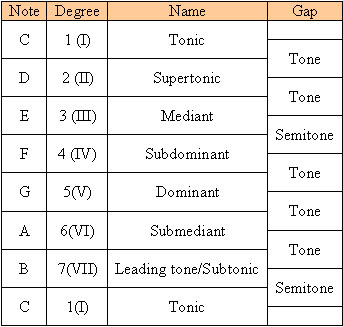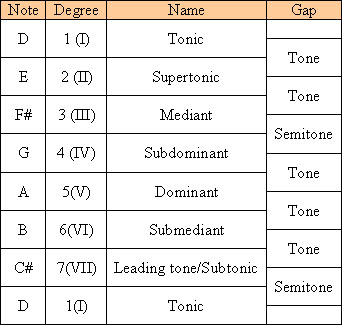Degrees of the Scale (lesson)
Intervals Triads Chords & Harmonies - Part 1 Degrees of the scale
Introduction
Greetings all, and welcome to the latest GMC Theory Lesson!
In this multi part lesson we are going to build on our knowledge of the major scale, and start looking at a couple of key concepts around chord and harmony construction. When we are done, you'll be able to understand complex relationships between notes, harmonize a lead line, construct a B augmented chord, and leap tall buildings in a single bound ...
Degrees of the Scale
All of the above starts simply with a concept that should already be familiar to you as the formula for a Major Scale. If you are not familiar with major scales, check out the major scale lesson here. Next, we are going to learn about degrees of the scale - this is a system for talking about notes in a scale without reference to the notes themselves, or what scale they are in. This is a little boring for now but will help us a lot later on.
You should remember that starting at the root note of a scale, and applying the Whole/Half formula, we can generate the scale. For those of you that have forgotten, the formula is:
W W H W W W H
Technically, we should be calling the whole notes tones and the half notes semi-tones, so I am going to rewrite the formula with different letters, to remind you of this:
T T S T T T S
So far so good, but where is this leading? Well the formula above tells us about the gaps between different notes of the scale, but we need a way to refer to the notes themselves, and we do this by a system of numbers and names. We start with the root of the scale and give that the number 1, (sometimes roman numerals are used), and count up one for each note in the scale. Each of these numbers is a degree of the scale, each degree also has a name.
For example, the scale of C has the notes C,D,E,F,G,A,B,C according to our formula. We would number them as in the table below. I am also showing you the formula steps, and the name of each degree.
Notice, that when we get back to C an octave higher, we call it the Tonic again, and call it the 1st degree, as in scale terms the two notes are equivalent. Also note that the 7th note can be called either the leading note or subtonic.
What does this buy us? Well, lets look at the scale of D major in the same way:
As you might expect, although the notes are completely different, the names, degrees and Gap formula all remain exactly the same. So what we have here is a way of talking about the relationship between different notes in a scale regardless of the actual notes themselves. If we want to talk about the 3rd note of a scale, it performs the same musical function regardless of the key, and we now have a language to talk about it that is independent of the actual note or scale. In our examples above, E in the scale of C, and F# in the scale of D are both 3rd notes, and anything we want to say about 3rd notes relates to each equally. This will come in very handy later on.
As a final note for this lesson, you will be pleased to know that the formal names (Dominant, Tonic etc) are rarely used. Most people refer to the numeric degrees of the scale, so if you can't remember the names don't worry!
In the next lesson will see how we can use degrees of the scale to understand intervals, and from there we move on to chords and harmonies!
Editorial note: published 24 Sept 2007







